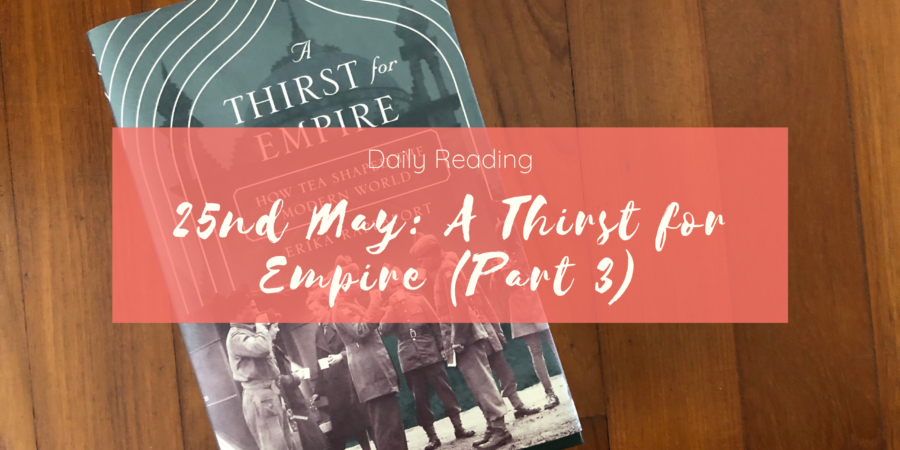I’ve finished A Thirst for Empire, as planned, so I’m pretty confident that I can finish the third tea book (Empire of Tea) by the end of the month!
The second section ended on a relatively high note for tea, as we see that it had become part of a national characteristic of the British Empire by the time of WWII. Part three, titled “Aftertastes”, however, brings us on the decline of the British Empire and how that affected tea. The last chapter is titled Legacies of Empire during the Sixties, but it does touch on seventies, making this book span from the 17th century to the 1970s.
One interesting thing trend I noted was the trend in exports from various countries. India “slowly lost its dominance of the global tea trade, even as it grew into a formidable consuming nation”, Indonesia’s tea trade was damaged greatly by “war, occupation, and independence”, while China started to export tea once again and by 1990 was the second largest tea exporter in the world.
The book does have the intriguing line that “the virtue of this export drive has been questioned, however, given the decline in average world prices” but sadly does not elaborate on what this export drive is (I assume it’s Chinese) or how it has been questioned. I’m guessing it’s the fact that tea has become so cheap that quality has been sacrificed and farmers have been trapped by the low profit margins, but I’m not too sure.
There was an intriguing section on the failed attempts of the tea industry to market to Americans. While A Social History of Tea ended on a relatively high not about the revitalisation of tea in America and Britain, A Thirst for Empire talked about the failure to market. There’s a study by Ernest Dichter who proposed that “the American youth is imbued with what may be called an ‘anti-tea’ attitude.” He recommended that “tea needed to eradicate its associations with England, Empire, and Women” when advertising to an American audience, but apparently the campaigns did not do much to shift American tastes of drink cultures.
There’s also a lot of discussion about the decline of tea in England. Apparently, the fact that tea had imbedded itself as part of the culture meant that it was rejected by British youths who wanted to partake in alternative/new culture.
One last thing that I thought was interesting was a 1960s surveys conducted on “thousands of Britons about their “attitudes” towards beverages, brands, and the consumer culture that surrounded commodities.” We can see that the xenophobic marketing of the 19th century is still present by the attitudes towards Chinese teas as “weak and scented” and statements such as:
“I didn’t know the Chinese liked tea.”
“The Chinese couldn’t know how to make good tea.”
Which is ridiculous. But it’s eye-opening to see how tea has gone from being a foreign object to something so ‘British’ that the British are unable to think of ‘foreigners’ being able to make good tea.
This has been a good reread. I’m glad that I bought my own copy of A Thirst for Empire because every time I reread it, something new catches my eye. It’s pretty academic, but it’s not inaccessible and the amount of information in here is great. Would definitely recommend to people who want to learn more about the politics and impact of tea in the British Empire.
ETA: Quick update on the morning of the 26th May. I’ve started reading Empire of Tea and the accounts of the cargo ships reminded me that this section of A Thirst for Empire also talked about the Cutty Sark, which I visited last year! I didn’t really think of how the backers (big players in the tea industry) would affect the presentation of tea in the exhibition, so that was pretty nice food for thought!
